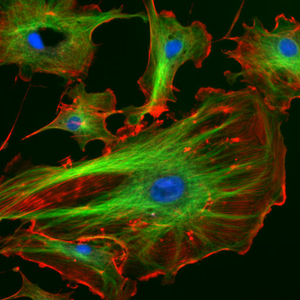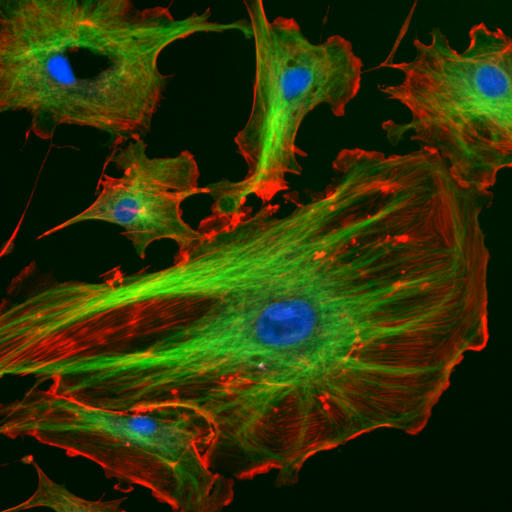How Cells Regulate the Length of Filaments
Many important events in a cell, such as dividing in two, are choreographed by filaments that can maintain a fairly steady length despite molecules that continually add to and subtract from their length. In Physical Review Letters, two German groups independently model this precise length regulation, which involves molecular motors that move along the filaments and shorten them when they get too long.
Filaments act in many critical biological processes, from determining the shapes and mechanical properties of cells to providing “highways” to transport material. Microtubules, for example, allow pairs of chromosomes to separate in a dividing cell. The filaments consist of polymers that must maintain a precise length, even though their individual subunits are constantly removed and replenished. In the past few years, experiments on biological molecules have shown that control of microtubule length depends on the presence of specific “motor proteins,” like the ones that move along the filaments to drive muscle motion or that move cargo within the cell.
According to the experiments, when a specific type of traveling motor protein reaches the end of the filament and detaches, it takes one of the subunits with it, shortening the polymer. Fresh motor proteins constantly attach to the filament from the surrounding fluid, arriving with equal likelihood anywhere along its length. Thus, if for some reason a filament grows longer, it will attract more motor proteins, which will increase the rate of shortening. Similarly, a short filament will attract fewer truncating motor proteins and will grow. The balance between steady addition of subunits and this length-dependent truncation determines the average length of the filament.
The steps in this process occur randomly, so one would expect the length to fluctuate widely around the average. In contrast, two German teams, from Ludwig Maximilian University in Munich and from Saarland University in Saarbrücken, find much less length variation in their models. Observations in cells suggest that the length variation can be very small, although no one has directly measured it.
Both papers examine a simple, one-dimensional model containing five parameters: the polymer’s rates of growth and shrinkage and the motor protein’s rates of attachment, motion, and detachment. They then calculate which combinations of parameters avoid unlimited growth or shrinkage, and how tightly the length can be controlled. Under the best circumstances, the teams find that the length variation of filaments is a small fraction of the total length, as required for some of their biological functions.
The teams attribute the precise length regulation to “traffic jams” that occur whenever a filament is long enough—motor proteins keep joining the “parade” along the filament until none of them can move without the ones ahead getting out of the way. Even though the individual events occur randomly, the jam occurs at much the same place for each filament, and the resulting high density in the jam ensures that the filament is clipped there. “Those traffic jams give the microtubule a way to measure how long it is,” says Erwin Frey, leader of the team at Ludwig Maximilian University.
The two papers differ in the direction of motion of the motor proteins. Frey’s group studied motor proteins like those in the recent microtubule experiments, which move toward the end of the filament where new polymer units are being added. The Saarland University team, led by Karsten Kruse, considered a different type of motor protein that moves toward the opposite end from where new units are added. Kruse says this “treadmill” behavior is sometimes seen for microtubules, as well as for other structural filaments in the cell.
In spite of this difference, for most parameter values, “the predictions are very similar,” notes Frey. Both he and Kruse are hopeful that future experiments will be able to test the predictions by measuring the relationship between the length variations in individual filaments and the molecular environment. Anatoly Kolomeisky of Rice University notes that “there is still a gap between theory and experiments,” because real microtubules have parallel bundles of many polymers. But these differences may not be important, he says. “The exciting thing is that the model, although very simple, still can capture the main features. You don’t need complex computers—it’s paper and pencil work. It’s the power of ideas.”
–Don Monroe
Don Monroe is a freelance science writer in Murray Hill, New Jersey.





